
|   |

|   |
Suruchi: Glimpses of the Aarohan to Beauty - Dr. S D Desai e-mail: sureshmrudula@yahoo.co.in November 21, 2014 With his wisdom culled from Sanskrit treatises, eminent Gujarati poet Rajendra Shukla in his inaugural talk on Saundaryaanubhava, the experience of beauty, set the tone and direction for Rasadhwani’s ‘Suruchi’, a six-day Dance Festival with a seminar and workshops, every day. The pursuit of beauty is an ascent, he said, to the highest point, Shringa, of ananda. The shringara-rasa-nishpatti is in that rare final state of the experience of beauty. The precondition to this anubhava is exclusive concentration on the object of beauty. With it, one can see Swaadhina-bhartrika nayika in the union of two leaves on a tree and Khandita Nayika in their parting. Even more significant than the launch of his dance annual ‘Attendance 2013-14’ on Telugu Traditions, competently guest-edited by Dr. Ananda Shanker Jayant, at the hands of Yogendra Gohil, Chairperson, Gujarat Sangeet Natak Akademi, was Ashish Khokar’s presentation ‘A Century of Indian Classical Dance’, tracing the evolution of the form made possible by the passionate dedication of stalwarts like Balasaraswati and Rukmini Devi to the art form, which left the Rasadhwani director Uma Anantani and a few others emotional. That’s how art magically connects as also forms and strengthens a bond. His urge in flawless English, simple and fluent, to respond to the calling from within and ardently follow it single-mindedly, the glow in their eyes suggested, touched some of the young aspiring dance learners’ inner chords. Significantly, with or without the use of that word, that calling remained a point of reference from time to time all through the festival. In fact, though Kumudini Lakhia was not present at this presentation, she happened to mention it in her inspiring valedictory address that her very intelligent disciples like Daksha Sheth and Aditi Mangaldas could do anything else brilliantly but instead they followed their calling. The young participants were, incidentally, visibly thrilled to hear her say, ‘For me, as a dancer, my body is the temple and dance is my religion.’ Aarohan and aesthetics  Tat-sat 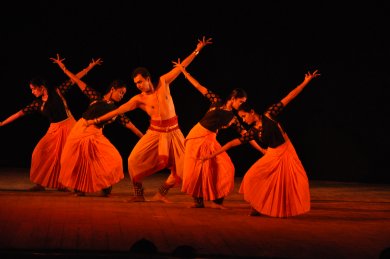 Trayyanta On the first evening, the well-knit group of dancers (Shivangee, Akshay, Koral, Ashwini , Chintan, Sachchidanand) from Rasadhwani encapsulated in Tat-sat the essence of the Vedic exposition of the mystic connect between the Creator and His Creation, the universe. In Dr. Uma Anantani’s choreography it presents pleasing clusters of images of human consciousness rising from Mulaadhar Chakra and going up across five more culminating in a thousand-petal Sahasrara Chakra. The mystic dimension of this production is particularly enhanced by the chants and an informed musical score by Jayan Nair besides Arpita Dhagat’s light design. The same theme finds expression in the Upanishads as the invisible ascent of the aatman (Self), steering clear of rituals, through invocation of inner powers to the state of Brahman (the Ultimate Reality) and integrate into it with parama aananda. In Sankhya’s Trayyanta, Vaibhav Arekar gives a feel of this aarohan through the awakening within. Dhrupad in the varying range of its delectable tempo and the lights that enhance the subtly meditative mood remain integral to Vaibhav’s spellbinding performance that, punctuated from time to time with nritta pieces in Bharatanatyam, portrays a credible journey from recognition (Tat Tvam Asi!) to realization (Soham!). With the relevance of the subjects and the expertise of the speakers, the daily morning seminars, first of their kind in Ahmedabad in recallable memory, were a welcome source of knowledge for the young participants. Madhuri Deshmukh made an interesting power-point presentation on ‘The Aesthetics of Aharya’ with authentic information on what Natya Shastra mentions as the fourth aspect of abhinaya. Though details relating to the origin and development of each classical form gave listeners the right perspective, in the light of the one-hour format, she would have been more welcome to bring to their attention significance of the details of costumes and jewellery in each form. Dr. Uma Rele’s perkiness and ringing singing voice were additional dimensions to the intrinsically lively subject of Nayika Bhedas she spoke on with slides to illustrate the nayikas as depicted with lyrical delicacy in medieval paintings and sculptures. The moods of a young beautiful expressive woman, portrayed by Bharata with such exquisite nuances of difference, have inspired some of the best dancers, painters and poets. A point that came up in a lighter vein for a while during interaction was whether modern girls would always like to depend for their feelings on the vagaries of the nayaka’s ways! Varying performances
It was a treat viewing Nalanda’s three dainty performances on Day Three in the evening and listening to its Director Dr. Kanak Rele’s talk on ‘Body Kinetics’ the next morning. The spiritual import remains ingrained in the three accomplished Mohiniattam dancers Krishna, Megha and Saji’s performances - Sakhi hey... (II.6) from Geeta Govindam, Thampi’s famous lullaby Omana Tingal... and Kubja, Dr Rele’s modern interpretation, oozing visually pleasing lyrical charm. The shared human sentiments of shringara, vaatsalya and longing, expressed also in soulful music, particularly in Girishan’s vocal rendering, effortlessly and convincingly culminate in a spiritual experience. Watching Raatri in stylized Seraikella Chhau dance style one gets reminded of a leading Gujarati poet’s Nisheeth hey! Nartaka rudra-ramya! Combining sight and sound, Shashadhar Acharya’s dance disciples portrayed both these aspects of the night – beautiful and awe-inspiring. In this sub-genre of Chhau, recognized as part of our ‘intangible national heritage’ by UNESCO, there was also representation of the elegantly swimming swan and the peacock with all its grace. In Radha-Krishna it is Radha who, for a change, plays the flute and Krishna dances to its strains! A glimpse of the secret of the magic cast by dancers from Nalanda could be had at Dr. Kanak Rele’s talk. An exemplary attitude to learning in an art form through modesty and perseverance, a research-based passionate pursuit and the keen desire to pass on the knowledge acquired to the generation next patiently, stressing absolute discipline where necessary. Dr. Rele’s scientific approach to art, exemplified in the nuanced explication of the alphabet of minute anga-upanga movement, of ‘volution’, ‘revolution’ and ‘kinesphere’ in impeccable English, demonstrations by her three disciples amazed everyone. A lifetime is not enough to come to terms with an Indian classical dance form! 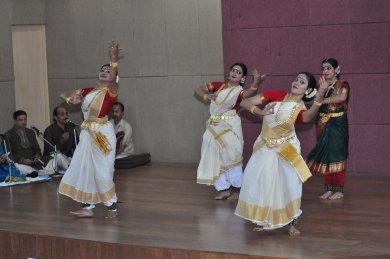 Body kinetics 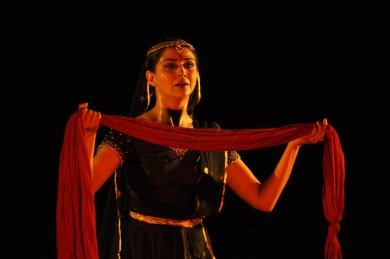 Rage and Beyond  Gati Pravaah
Kumudini Lakhia’s disciple Sanjukta Sinha presented two spell-binding abstract performances, Gati Pravaah and Tarana. The sight and sound, impeccably in tune, gave a feel of flowing lyrical movement with the pada-gati, hasta-mudras and netrabhinaya remaining harmoniously coordinated. Though abstract, Gati Pravaah for a while conjured up, by way of a welcome surprise, flitting images on the line ood jaa re Kaaga le jaa sandesh...! With observations on aharya still fresh, the viewers saw in Tarana the red of the dancer’s costume tastefully set in relief with gold bindis, teeka and earrings. Enhancing the beauty of dance Dr. Malati Agneswaran engaged the young participants’ attention on the theme of ‘Interdependence of Art Forms’ with slides and references to Natya Shastra. It is common knowledge to those taking even initial dancing steps how sahitya and sangeet are integral parts of the pursuit of classical dance. The speaker grew more engaging when she showed how there is the fundamental connection between dance, sculpture, painting and even music because all of them seek to express the most minute of human sentiments. For a prospective Geeta vaadhya taalanuvarthini dancer Nalanda (Mumbai), probably, would not have had a better guru to impart training in rhythm according to the indigenous tradition than Ambika Viswanath, who in her compact presentation on ’Aesthetics of Taala’ blazed a trail for the budding dancers to follow along with their major dance pursuit. Rhythm is like pulse beats, she said, and it enhances the beauty of dance. Be it the initial invocation, demonstration of nibaddha and anibaddha strands of music with inbuilt silent pauses, or music accompanying nritta, her concentration and spiritual attitude to music never wavered. 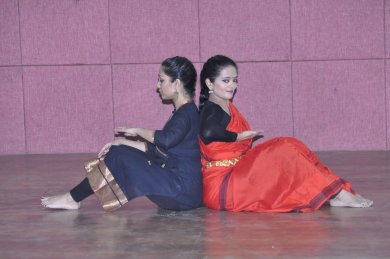 Demo 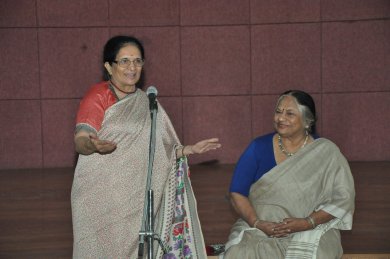 Dr. Uma Anantani & Kumudhini Lakhia Vaibhav Arekar’s demonstration of ‘Story Telling through Dance’ set in warm informality on the day of valediction earlier mentioned to ‘Suruchi’, the dance-cum-seminar festival. Vaibhav combined abhinaya as in both dance and drama besides hilarious mime. Owing to unavoidable circumstances, Lalitha Venkat could not come but had sent a paper on ‘Dance Writing and Dance Criticism.’ Drawing from her own experience and quoting well-known dance critics, she made useful suggestions to dance writers. Among them were to write about the performance and not the performer, to be modest to do research and be polite even while criticizing, as also to be familiar with dance forms and simple in language. ‘Suruchi’, the enriching dance-cum-seminar event, had workshops every afternoon, which the participants fully enjoyed. They were knowledgeably conducted by Sanjukta Wagh, Nidhi Wadhva and Sushant Jadhav. Twin sisters Gargee and Shivangee Anantani along with their energetic team kept everything going with pleasing smoothness. Dr. SD Desai, a professor of English, has been a Performing Arts Critic for many years. Among the dance journals he has contributed to are Narthaki, Sruti, Nartanam and Attendance. He guest-edited Attendance 2013 Special Issue. His books have been published by Gujarat Sahitya Academy, Oxford University Press and Rupa. After 30 years with a national English daily, he is now a freelance art writer. |